ASUS N53JF: Midrange 15.6” 1080p, Take Four
by Jarred Walton on December 28, 2010 1:40 AM ESTASUS N53JF: Performs as Expected
Performance is pretty much right where you’d expect, given the hardware. It has the same GT 425M GPU as the Clevo B5130M and the i5-460M CPU is fractionally faster than the i5-450M in the XPS 15, so performance typically falls in between the two. Battery life is somewhat hampered by ASUS’ continued use of 48Wh batteries in their N-series, something we’ve complained about in the past. The U-series’ 84Wh batteries don’t feel much heavier than the 48Wh, and size is close enough that a slight reworking of the N53JF could have accommodated the larger battery. However, ASUS does do a reasonable job at power management, so even with a smaller battery than the competition it remains competitive. Here are the application results, followed by gaming and battery life.
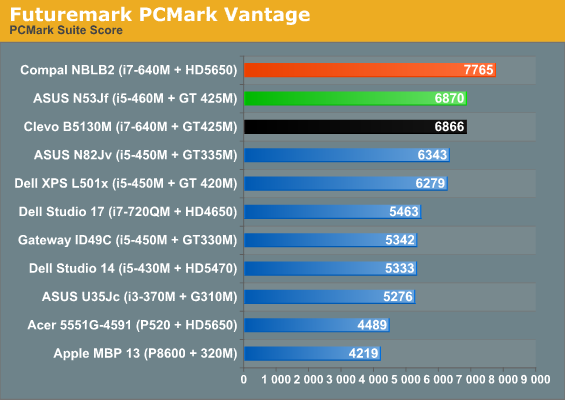

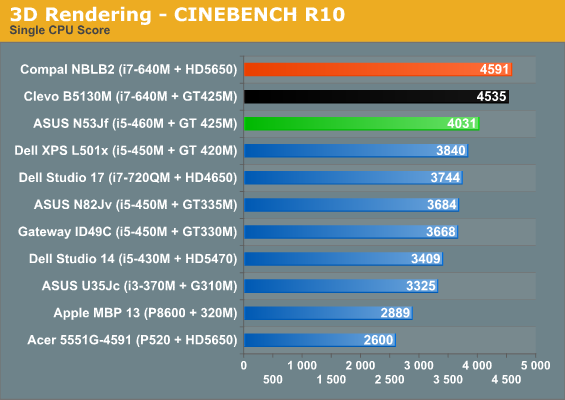
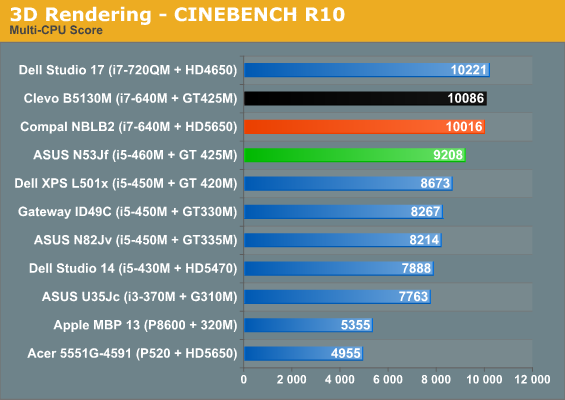
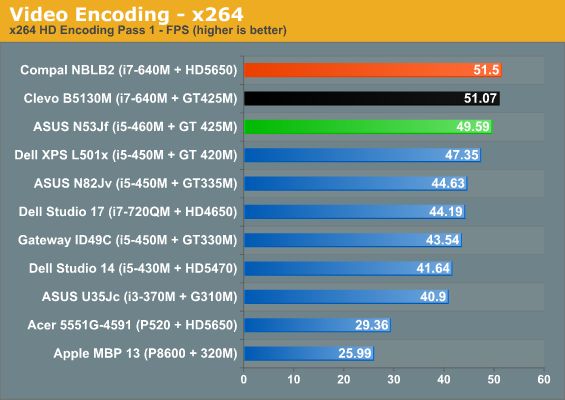
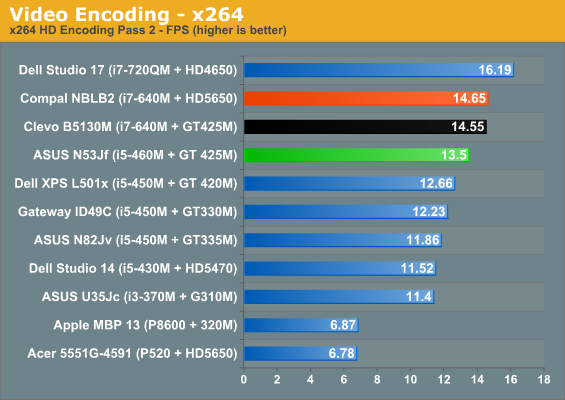
Starting with these general performance metrics, the N53JF is usually about 5% faster (sometimes as much as 10%) than the XPS 15, which goes with the CPU upgrade, with perhaps a few extra performance optimizations by ASUS. The Clevo and Compal laptops both have a faster i7-640M CPU so they come out ahead, but other differences come into play. In PCMark, the Clevo and ASUS laptops are nearly equal, but the Compal comes out 13% faster in Vantage and 23% faster in PCMark05—perhaps thanks to the HD 5650 discrete GPU. Once we hit the pure CPU tests of 3D rendering and video encoding, the charts fall into line and the i7 CPU outpaces the i5-460M by 8-10%.
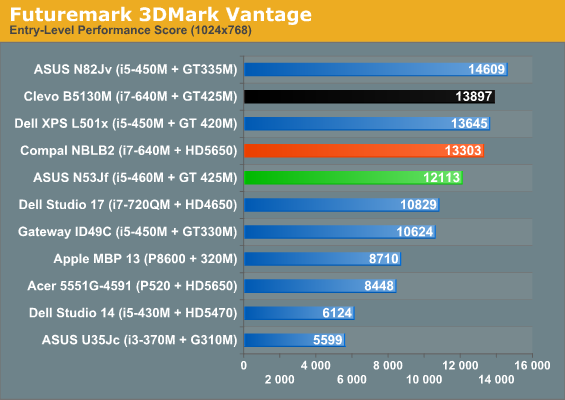
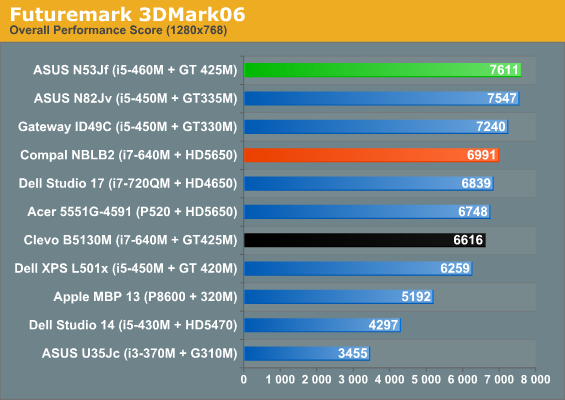
3DMark numbers aren’t a major focus for us, for good reason. Here we see the N53JF leading by up to 22% in 3DMark06, but then it trails by up to 15% in Vantage. Yeah, go figure. The Performance score in Vantage is 3559 for the curious. The 3DMark03/05 numbers aren’t any better (no graphs on those): 16612 in 03 and 13397 in 05 put it slightly ahead of the Clevo and Dell laptops, but the HD 5650 is 3% faster in 05 and 30% faster in 03. The reason for the large lead in 03 is that Optimus appears to be a bottleneck on ultra-high frame rates; the PCIe bus gets saturated, so when you start to try and push more than ~150FPS (i.e. in the Wings of Fury benchmark) you hit a hardware frame rate bottleneck. Given the level of hardware and the frame rates where this manifests, however, it’s nothing we’re concerned about—it should only show up in older titles that really don't stress the GPU much.










65 Comments
View All Comments
anactoraaron - Tuesday, December 28, 2010 - link
That they would pack in USB 3.0, bluray and then put in that below average 1080p display. Not that it matters with Sandy Bridge on the horizon. Best advise is still to wait.ET - Tuesday, December 28, 2010 - link
It's nice to see 1080p becoming more prevalent at this size laptop, but why can't we see some higher res displays at 20"+? I had a 19" 1600x1200 CRT eight years ago, and resolution hasn't gone up since then, and even dropped from 1920x1200 to 1080p in recent times. Laptops these days have some high DPI displays and I'd love to see some on the desktop.Ushio01 - Tuesday, December 28, 2010 - link
1920x1080 monitors are replacing 1680x1050 TN panels in the mid range monitor segment just as 1680x1050 replaced 1280x1024 monitors with the advantage of either 120hz TN or IPS screens. 1920x1200 monitors still exist and are just as expensive as always along with the 2560x1440 and 2560x1600 in the high and very high end segments.jabber - Tuesday, December 28, 2010 - link
1080p will be a curse for us all in a couple of years time.Never will a standard have been surpassed and found wanting so quickly.
They should have made it 1440p at least.
Now us computers users have to suffer from the display world being lazy and sticking to a screen depth not much more that what we were used to 10 years ago.
Thats progress.
DanNeely - Tuesday, December 28, 2010 - link
I think the main bottleneck for the resolution picked for the HD standard was the capacity of dtv broadcast/blueray/hddvd disks without any compression artifacts. Bumping the frame sizes up 77% would have needed a significantly higher compression level and would've resulted in the videophiles who're currently reviling netflix/hulu/etc's streaming offerings for low quality to have slammed the new standards; potentially rendering them stillborn at birth, and almost certainly slowing adoption down significantly.The other hangup would be the size of the TV screen needed to get full use of the resolution in the living room. 1080p is generally not worthwhile on less than a 40" screen because the angular size of the pixels at 720p are too small to resolve at couch distance. The smaller pixels of a 1080p screen won't be visible as individual pixels until about 56". At the time the standards were being written 56" was an enormously large TV. It's still larger than most TVs sold today.
Until that changes (and bluerays, or the bandwidth needed to stream them at full quality, become commodity items) I don't expect anything to change on the consumer video market. When that happens I expect the new standard will be one of the 4k resolutions; probably either 3996×2160 (1.85:1) or 4096×1714 (2.39:1). We'd also need a higher density video cable standard. DP 1.2 will carry the 2d version of either signal, but would need doubled again to support 3d. Hopefully lightpeak will be mainstream by then and able to carry the data.
TegiriNenashi - Tuesday, December 28, 2010 - link
2.39:1 ? That is insane.DanNeely - Tuesday, December 28, 2010 - link
It's the wide-wide screen mode at theaters today. IT would render all but the largest desktop computer displays too short to be useful for anything except consuming content. The video industry would see this as a feature.TegiriNenashi - Tuesday, December 28, 2010 - link
I don't think letterbox has any future in the movie industry itself. Avatar 3D was rendered at 1.78 : 1. Let the 2.39:1 die, the sooner the better!Hrel - Tuesday, December 28, 2010 - link
here hereJarredWalton - Tuesday, December 28, 2010 - link
Hear, hear?